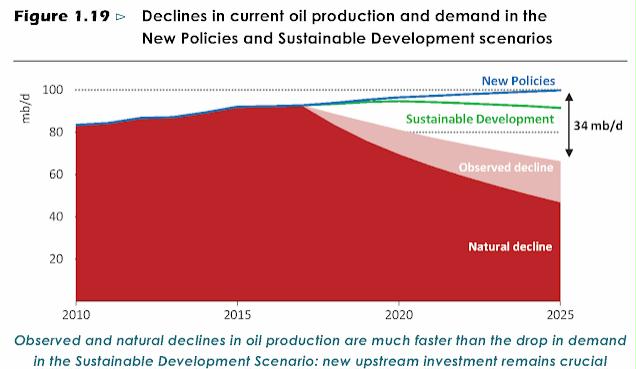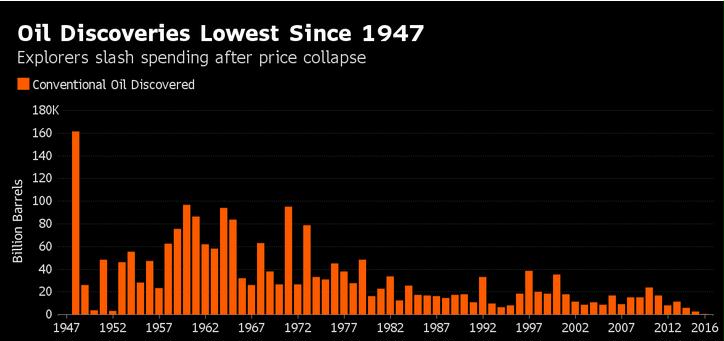Preface. Excerpts from the cleantechnica article below make it clear why there is likely to be a supply crunch as soon as the early 2020s, and the investment implications.
Here’s what I’ve gleaned from other summaries of the report.
Although many hope that oil companies will drill for oil when prices go up and close the supply gap looming within the next few years, very little oil has been found to drill for for several years now.
The European IEA 2018 report also says that shale oil will not rescue us, and is likely to peak in the mid-2020s. Yikes! U.S. fracking accounted for 98% of the increase in world-wide oil in 2018 (Rapier 2019).
The U.S. EIA is grossly overestimating how much shale oil & gas can be produced. “It is worth reiterating that after an initial burst of production, shale wells decline rapidly, often 75 to 90 percent within just a few years. Growing output requires constant drilling. Also, the quality of shale reserves vary widely, with the “sweet spots” typically comprising only 20 percent or less of an overall shale play, J. David Hughes writes in the Post Carbon Institute report (Cunningham 2019).
And if fracking doesn’t peak geologically, then it may well financially crash, since the industry is spending more money on drilling than what it sells shale gas for (Silverstein 2019).
Oil companies do have money, but they haven’t been drilling because there’s no cheap oil to be found, so instead they’ve been spending their money buying their shares back.
From crashoil.blogspot.com: World Energy Outlook 2018: Someone shouted “peak oil”
This excerpt is in Spanish translated to English by google. It shows a civilization crashing 8% decline rate that the IEA hopes will be brought to an also civilization crashing 4% rate with new oil drilling projects.

“How is this alarming graph interpreted? According to the text, the red is what they call “natural decline” and corresponds to how oil production would decrease if the companies did not even invest in maintaining the current wells; As explained in the report, it is 8% per year. The pink area corresponds to the “observed decline” and is what the IEA inferred how production will actually decline if companies invest what is needed for the correct maintenance of the current deposits. This decline corresponds to 4% per year. If new deposits are not produced, in just 7 years from now we will find that the production is 34 Million barrels per day (Mb / d) below where it is expected that the demand will be, or about 25 Mb / d below the demand much more moderate scenario of Sustainable Development. It is a huge hole of more than 35% of all the oil that is produced today.
In the text, the IEA warns us that there is nothing particular to worry about in this terrifying graphic because there will be exploitation of new deposits that will cover that hole to a large extent. However, they warn us, to avoid that hole we would need to find deposits with resources around 16 billion barrels each year…In short: the IEA is assuming…that production in 2025 will be lower than today’s (a deficit of 13 mbd in 2025). In essence, peak oil.”
It isn’t likely oil companies will make up the difference In 2016, only 2.4 billion barrels were discovered (versus 9 billion on average the past 15 years). In 2017, about 7 billion new barrels were discovered. As you can see below, there’s been an alarming lack of new crude oil found.

And it’s not just cleantechnica saying there will be oil shortages, here are some other articles about the coming oil crunch: Bloomberg, NASDAQ, oilprice.com, axios calls the shortage as by 2023, financial times also by 2023
Enjoy your life for the next few years, beyond that there’s no guarantees. Some regions will fare better than others though.
Here’s one of the best articles about where global oil production stands today, which concludes “When US shale oil peaks and Iraq can no longer increase production there will be some surprises for a complacent world which should have used the 2008 oil price shock as a warning to get away from oil”: Matt Mushalik. 2019. World crude production outside US and Iraq is flat since 2005. Crudeoilpeak.info
Alice Friedemann www.energyskeptic.com author of “When Trucks Stop Running: Energy and the Future of Transportation”, 2015, Springer, Barriers to Making Algal Biofuels, and “Crunch! Whole Grain Artisan Chips and Crackers”. Podcasts: Derrick Jensen, Practical Prepping, KunstlerCast 253, KunstlerCast278, Peak Prosperity , XX2 report
Nov 22, 2018. Peak Oil & Drastic Oil Shortages Imminent, Says IEA. Cleantechnica.com
On page 159 of the IEA 2018 World Energy Outlook the following graph can be found: It is clear that Peak Oil will be hit well before 2020, while demand keeps on rising, unless the world’s Oil Majors and State Owned Oil Companies massively invest in new exploration.
It is clear that Peak Oil will be hit well before 2020, while demand keeps on rising, unless the world’s Oil Majors and State Owned Oil Companies massively invest in new exploration.
However, the Oil Majors already have heavily spent money on new oil exploration in the years after 2000, where a fossil fuel hype with an accompanying coal boom lead up to an oil price of over $150 in 2008. While this oil price proved unsustainable for a crashing world economy, this oil exploration boom lead to very little new findings in the big scheme of things:
So what does that mean?
It means that a collapse of oil supply to half of its current size within only six years simply cannot be compensated by new oil findings and certainly not by unconventional oil sources like oil sands and fracking. That the Oil Majors did not pick up with new oil exploration after the oil price rose again to $100 per barrel in the years after 2008 is another sign that the world is already “overexplored,” as geologists put it. Instead the Oil Majors concentrated on a stock buyback, knowing full well that further exploration would be a waste of money while they are sitting on oil that will become very valuable even though the amount of oil they will extract will decline significantly.
In summary, the Oil Majors and State Owned Oil Companies (in this field notably the Initial Public Offering (IPO) of Saudi-Aramco, the world’s biggest oil company, has been scrubbed) are waiting for an oil price bonanza to happen, while the IEA is very concerned about future oil supply.
Notably the Peak Oil graph from the IEA (first graph in this article) has been unearthed by the Association of Study of Peak Oil and Gas (ASPO), which as an organization has itself published multiple studies on Peak Oil. While ASPO has put Peak Oil sooner than the IEA, in its latest study already at 2011 for conventional crude, it is remarkable that the IEA refuted this claim back then with the statement that Peak Oil would not be reached before 2020. Well, it surely looks like they corrected that statement for themselves now.
So what does that mean for investors in oil and the world economy?
Surely there could a handsome profit be made by riding the coming oil shortages, but one has to keep in mind that while the oil price may go through the roof, the barrels that can be sold also shrink fast and drastically. So there remains the question of how high the profits of the Oil Majors will rise and how much will this be appreciated by the stock price for these clearly dying companies. Furthermore, with these rapid stock swings, you compete with banking supercomputers that act in a millisecond timeframe, so you would have to be alert night and day for the point when the crash will come because of the world economy not being able to take the oil price anymore. As a conservative long term investor, this can only mean to get out of these stocks as soon as possible, while risk-loving investors can try to make a quick buck on the coming stock volatility, with the world economy crashing a couple of times due to ongoing undersupply in oil.
References
Cunningham, N. 2019. The EIA Is Grossly Overestimating U.S. Shale. oilprice.com
Rapier, R. 2019. The U.S. accounted for 98% of global growth in oil production in 2018. Forbes.
Silverstein, K. 2019. Will the red ink ever wash out of the U.S. shale gas industry? Forbes.

4 Responses to IEA 2018 World Energy Outlook: Peak oil is here, oil crunch by 2023